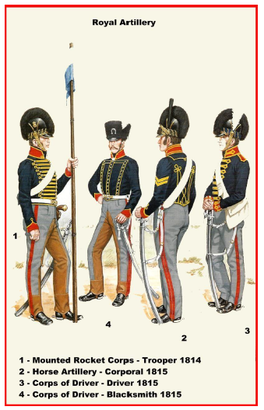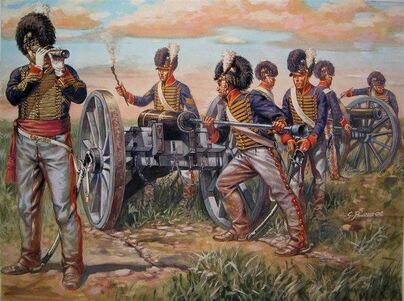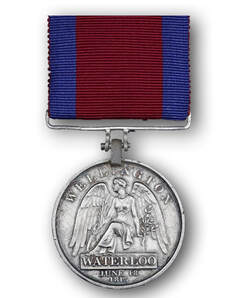|
Back in May I wrote a blog about Cotton Weavers in the Salford area and one of these was John Thelwell. This week’s theme is Service and John Thelwell took part in the Napoleonic War. John Thelwell was born in Gorton, Lancashire and enlisted in the Royal Horse Artillery in 1813 aged 20. He joined the most famous troop of horse artillery in the British army: “A” Troop, otherwise known as “The Chestnut Troop”, raised in 1793 and named after its chestnut-coloured horses with which it had served with distinction through the Peninsula War. In the year that John Thelwell joined the Troop it was in its fourth year of fighting its way from Portugal, through Spain, to southern France. On 21st June 1813 it fought at the key battle of Vitoria, which effectively won the war in Spain for Wellington. The ensuing pursuit of the French army back to and over the Pyrenees saw the Troop in action at engagements at San Marcos, La Rhune, Nivelle, Nive, St Pierre de Grube, Gave d’Oleron, Orthez, and La Reole. An end to the relentless fighting finally came in April 1814 with Napoleon’s abdication and exile to Elba. But with Napoleon’s escape, “A” Troop found itself back with Wellington’s army in Flanders and was in the thick of the fighting at Waterloo. On the morning of the 18th June this Troop was posted with two guns on the Brussels road looking down towards an abatis (a pile of wood blocking the road) next to the farmhouse of La Haye Sainte, a key position in the battle of Waterloo. The other four guns were placed to the right of the Brussels road, on the ridge, with a deep hollow way to their rear. This sunken lane was clogged with the limbers and horses of the Troop. At Waterloo the Troop had a nominal strength of 167 men: Captain Sir Hew Dalrymple Ross and four other officers 2 Staff Serjeants 3 Serjeants 3 Corporals 5 Bombardiers (the artillery equivalent to a Lance Corporal in the infantry) 81 Gunners – these men loaded and fired the guns 57 Drivers – these men rode and held the horses which pulled the guns and limbers. 6 Artificers (farriers, saddlesmiths, etc.) 1 Trumpeter The Drivers did not fire the guns but waited with the limbers which pulled the guns, this would
have been Driver Thelwell’s job. They needed to be ready to withdraw the guns at a moment’s notice and to also bring up more ammunition when needed. Each limber was pulled by 3 pairs of horses, each pair having one driver. John Thelwell would have worn the distinctive Tarleton helmet of the Royal Horse Artillery, carried a light cavalry sword slung from a belt, carried a short whip to control the horses, and worn a special boot reinforced with iron rods to stop his leg being crushed should his pair of horses come together. The Troop had 6 guns and as well as the 36 horses needed to pull these, there would also have been at least another 36 for the ammunition wagons, plus numerous other horses as spares and for various other wagons for the artificers’ equipment etc. As noted above, at Waterloo the Troop’s limbers and carts were tightly crammed into the sunken lane at the rear of the guns. This, then, is probably where John Thelwell was stationed for the battle. Upon La Haye Sainte falling to the French, the Troop came under musket fire from the farm and the four gun section was moved further along the ridge to the right. These guns were then charged by French Cuirassiers and the gun crews ran to the hollow way to escape or threw themselves under the guns for shelter. Around this time both the guns on the Brussels road were disabled. Of the four remaining guns three were also disabled later by artillery fire, leaving the Troop with just one serviceable gun. The Troop lost 8 men killed (plus an unknown number wounded), and 27 horses killed or lost. In 1816 all soldiers of the British Army at Waterloo were awarded the Waterloo Medal, the first of its kind in that it was awarded to all ranks. “Waterloo Men” were also rewarded by being credited with an extra 2 years of service (which was beneficial in terms of pay and pension). This information was provided to me by Martin Aaron of Waterloomen.com John was based in Ringmer at the Barracks during 1818 when he met Phillis Funnell my Great x 4 Grandmother and her son John was born 6 November 1818. By 1821 he had left the Army and married his first wife Nancy Potts back in Lancashire. I am now researching his life back in Lancashire.
0 Comments
Leave a Reply. |
AuthorKerry Baldwin Archives
June 2023
Categories |
|
Copyright Kerry Baldwin 2024
|
Proudly powered by Weebly
|



 RSS Feed
RSS Feed
